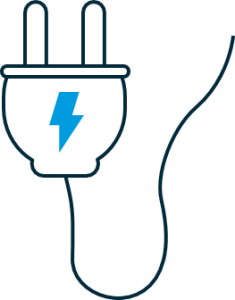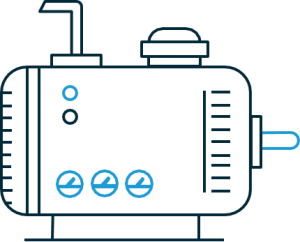Keep Operations on When the Lights Are Off

Businesses of all sizes can be impacted by a power outage, but for small to medium sized businesses (SMBs) in particular, a black out can be devastating. After all, a power outage equals downtime, which translates directly to lost revenue. An SMB is less likely to be able to absorb the impact of financial losses the same way that an established, stable enterprise does. So, taking steps to mitigate the impact of power outages should be considered an essential part of business continuity and disaster recovery (BCDR) planning.
Power outages, a leading cause of business downtime today, are on the rise. According to Inside Energy, a public media energy reporting initiative, the 5-year annual average of power outages doubled every five years between 2000 and 2014. In other words, power outages are four times more common today than they were 15 years ago.
This guide will help you better understand the tools and strategies that businesses use to minimize the impact of power outages. You'll learn why power outages occur and why they are becoming increasingly common. You'll also learn about preventative measures that can reduce the impact of power outages on your business. Finally, you'll learn how these preventative measures alongside a robust data protection strategy can reduce the financial impact of an outage.
WHY POWER OUTAGES HAPPEN
 According to a 2014 report from research firm Climate Central, weather caused 80 percent of all US power outages between 2003-2012, 59 percent of which was labeled as "severe weather". Non-weather events, such as accidents and equipment failure, made up the remaining 20 percent. The specific events ran the gamut from extreme cold to severe storms to heat waves, indicating that weather impacted businesses nationwide. Outages cost American businesses as much as $150 billion per year, according to the US Department of Energy (DOE), with weather-related disruptions costing the most per event. The majority of these large-scale outages resulted from damage to large transmission lines or substations, as opposed to the residential distribution network.
According to a 2014 report from research firm Climate Central, weather caused 80 percent of all US power outages between 2003-2012, 59 percent of which was labeled as "severe weather". Non-weather events, such as accidents and equipment failure, made up the remaining 20 percent. The specific events ran the gamut from extreme cold to severe storms to heat waves, indicating that weather impacted businesses nationwide. Outages cost American businesses as much as $150 billion per year, according to the US Department of Energy (DOE), with weather-related disruptions costing the most per event. The majority of these large-scale outages resulted from damage to large transmission lines or substations, as opposed to the residential distribution network.
While weather is the most common trigger for US power outages, a major underlying issue is the country's 100-year-old power grid. The grid, which has been described as "the largest machine on Earth" consists of more than 9,200 electric generating units with more than 1,000,000 megawatts of generating capacity connected to more than 300,000 miles of transmission lines, according to the DOE.
However, the grid was designed and built long before the wide array of technologies that rely on it today were around. The demand for electricity has skyrocketed in recent years thanks to population growth, air conditioning, and massive increases in personal and business technology use. Yet, the power industry invests very little in research and development — less than two percent of annual revenue, according to the DOE. As such, the grid is ill-equipped to keep up with today's needs. According to Climate Central research, climate change will increase the risk of weather-related damage to the grid, impacting millions of people, and costing tens of billions of dollars each year.
While it is not yet a common cause of power outages, it is worth noting that cyber attacks have caused at least one large-scale power outage. According to Computer Weekly, tens of thousands of customers in Ukraine's Ivano-Frankivsk region were without power for several hours on December 25, 2015 following an attack on two regional power distribution facilities.
REDUCE DOWNTIME FROM POWER OUTAGES
 The good news is that there are a number of preventative measures that businesses can take to minimize the impact of power outages. The level of protection required will be dictated by the specific needs of a business. So, it is important to evaluate a business' tolerance for downtime associated with power outages, and invest in preventative tools accordingly. In other words, there is no one-size-fits-all strategy for every business. Power outages can last anywhere from a few minutes to multiple days depending on the cause. Short-term outages will likely have a minimal impact, especially if there is no damage to the facilities or equipment. Long-term power outages, such as those resulting from a severe weather incident, tend to require planning to ensure that business operations can resume within a reasonable timeframe.
The good news is that there are a number of preventative measures that businesses can take to minimize the impact of power outages. The level of protection required will be dictated by the specific needs of a business. So, it is important to evaluate a business' tolerance for downtime associated with power outages, and invest in preventative tools accordingly. In other words, there is no one-size-fits-all strategy for every business. Power outages can last anywhere from a few minutes to multiple days depending on the cause. Short-term outages will likely have a minimal impact, especially if there is no damage to the facilities or equipment. Long-term power outages, such as those resulting from a severe weather incident, tend to require planning to ensure that business operations can resume within a reasonable timeframe.
Consider user cloud-based email and other applications, so users can easily work from home while your business is without power. Enterprise grade, cloud-based file sync and share (FSS) services can give users access to the files they need from anywhere, on any device. Not all outages are widespread regional events. Depending on the nature of your business, giving employees the ability to work remotely can be an effective method for returning business operations quickly.
Businesses are impacted by power outages in different ways. Obviously, without power, electronic equipment is inoperable. But, more importantly, power outages can cause devastating damage to a business's IT systems, which can significantly increase downtime after power is restored. This is because electronic devices, including desktop computers, servers, printers, etc., require a steady electrical current. When that current becomes irregular, permanent damage to system components can occur.
UPS and Surge Protection
 An uninterruptible power supply (UPS) is a device that ensures computer systems can stay on temporarily in the moments following a power outage, so they can be shut down gracefully to avoid losing data in memory (RAM). They also provide surge protection, to ensure that electrical current irregularities do not damage computer components. There are a wide variety of UPS devices available today, and a number of things to consider when selecting one. When evaluating a UPS, start with the needs of the protected systems, such as:
An uninterruptible power supply (UPS) is a device that ensures computer systems can stay on temporarily in the moments following a power outage, so they can be shut down gracefully to avoid losing data in memory (RAM). They also provide surge protection, to ensure that electrical current irregularities do not damage computer components. There are a wide variety of UPS devices available today, and a number of things to consider when selecting one. When evaluating a UPS, start with the needs of the protected systems, such as:
- Number of devices supported
- Types of devices (e.g., desktops, servers, networking equipment, other electronics, etc.)
- Power requirements for each device
You'll also want to consider specific UPS functionality. For example, many devices offer features such as:
- Automatic graceful shutdown of protected devices
- Customizable shutdown commands
- Power save mode
- Battery life notification
Pricing for UPS devices varies widely, and is largely dictated by the factors outlined above. Choosing the right device requires a careful consideration of your needs so you don't overspend. These devices can represent a significant investment. That being said, be careful not to underestimate your needs.
Generators
 Not every business requires dedicated generator power. For example, most businesses can tolerate the downtime associated with a short-term power outage. Also, many office buildings have standby generators that companies can rely on. However, if your business has specific requirements that necessitate a generator, such as a restaurant that relies on refrigerators for perishable goods, there are a number of things to consider.
Not every business requires dedicated generator power. For example, most businesses can tolerate the downtime associated with a short-term power outage. Also, many office buildings have standby generators that companies can rely on. However, if your business has specific requirements that necessitate a generator, such as a restaurant that relies on refrigerators for perishable goods, there are a number of things to consider.
First, you'll have to calculate the minimum wattage for your generator. To do this, you need to take an inventory of the equipment you need to power, add up the wattage, and multiply by 1.5 to account for the extra power necessary for equipment startup. There are also a wide variety of generator wattage charts available to help you determine the right generator for your business. Depending on your power needs, there are two types of generators to consider — portable and standby.
Portable generators are typically lower in cost and wattage than standby generators. They typically run on gasoline and must be manually started and plugged into an electrical sub-panel following an outage. Standby generators on the other hand are much more expensive, run on natural gas or propane, and are directly wired into a switch in your electrical system. They are designed to automatically turn on when power is cut. It is also important to note that some counties/cities require permits for generators.
HOW TO AVOID DATA LOSS FROM A POWER OUTAGE
 Avoiding data loss from a power outage is straightforward — you need a secure, second copy of your critical business data in a separate location that you can easily access in case your primary systems are damaged due to power loss or other data disasters. For businesses, backing up data is a fundamental part of responsible entrepreneurship. But, backup can mean a lot of different things. The approach that you choose to protect your data will have a dramatic impact on the speed and success of your recovery.
Avoiding data loss from a power outage is straightforward — you need a secure, second copy of your critical business data in a separate location that you can easily access in case your primary systems are damaged due to power loss or other data disasters. For businesses, backing up data is a fundamental part of responsible entrepreneurship. But, backup can mean a lot of different things. The approach that you choose to protect your data will have a dramatic impact on the speed and success of your recovery.
When it comes to backup, it's important to understand two concepts: recovery time objective (RTO) and recovery point objective (RPO). RTO is the amount of time that it takes to get a system restored following a failure or disaster event. RPO is the point in time to which data can be restored following the event.
When it comes to power outages, a solution that offers low RPO is essential. Let's say you perform a backup at 6PM every night. If a primary server was damaged in a power outage and failed at 5PM, the following afternoon, your RPO would be 23 hours. Any data created/altered within that timeframe would be lost.
Modern backup solutions take incremental backups of business data continuously throughout the day — some as often as every five minutes — to deliver a very low RPO. They also allow users to run production workloads from the backup server or in the cloud while restoring primary operations for low RTO.
If you are choosing a backup solution today, this type of functionality should be a serious consideration. Traditional backup methods can not deliver the low RTO and RPO of today's backup software and services. The ability to run applications from a cloud backup is particularly useful to prevent downtime during a long-term power outage. Data protection solutions allow businesses to access the critical applications they need to conduct normal business operations even when their on premises systems are without power.
CONCLUSION
 Power outages don't discriminate. They hit businesses of all shapes and sizes, in any region or industry. Black outs result in billions of dollars in losses per year. SMBs in particular are vulnerable to downtime and financial loss from a power outage and should take the appropriate steps to mitigate the impact of this type of event as highlighted above.
Power outages don't discriminate. They hit businesses of all shapes and sizes, in any region or industry. Black outs result in billions of dollars in losses per year. SMBs in particular are vulnerable to downtime and financial loss from a power outage and should take the appropriate steps to mitigate the impact of this type of event as highlighted above.
The steps you take to prevent downtime from power outages will largely be dictated by the specifics of your business. At a minimum, you should protect your electronic equipment against power surges and ensure they can shut down properly in the event of an outage. Cloud applications can help some businesses by allowing employees to work from home (as long as they have power). Backing up data should also be considered essential, in case the above measures fail. You also may need to invest in a generator. If you do, be certain that you size it properly for your power requirements and check local regulations to verify whether or not a permit is needed.
With proper planning, you can greatly minimize the impact a power outage will have on your operations. Determine the amount of power outage downtime your business can tolerate, and build your strategy around that.


